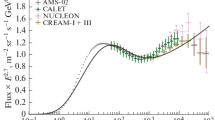Abstract
TAKING the confinement mechanism for cosmic rays in the Galaxy to be resonant scattering by Alfvén or hydromagnetic waves generated by the streaming of the cosmic rays themselves1,2, I shall show that the abundant low energy cosmic rays can generate, indirectly, enough Alfvén waves of long wavelength to scatter cosmic rays of considerably higher energy. Cosmic rays of energy up to around 1,000 GeV may thus be confined within the Galaxy more efficiently than has previously been supposed.
Similar content being viewed by others
References
Kulsrud, R. M., and Pearce, W. P., Astrophys. J., 156, 445–469 (1969).
Wentzel, D. G., Astrophys. J., 156, 303–314 (1969).
Chin, Y. C., and Wentzel, D. G., Astrophys. Space Sci., 16, 465–477 (1972).
Skilling, J., Mon. Not. R. astr. Soc., 172, 557–566 (1975).
Skilling, J., Mon. Not. R. astr. Soc., 173, 245–254 (1975).
Skilling, J., Mon. Not. R. astr. Soc., 173, 255–269 (1975).
Cesarsky, C. J., thesis, Harvard University (1971).
McIvor, I., 14th Int. Cosmic Ray Conf., Munich, 2, 627–631 (1975).
Author information
Authors and Affiliations
Rights and permissions
About this article
Cite this article
SKILLING, J. Cosmic ray streaming. Nature 258, 687–688 (1975). https://doi.org/10.1038/258687a0
Received:
Accepted:
Issue Date:
DOI: https://doi.org/10.1038/258687a0
- Springer Nature Limited
This article is cited by
-
Electron-Ion Temperature Equilibration in Collisionless Shocks: The Supernova Remnant-Solar Wind Connection
Space Science Reviews (2013)





